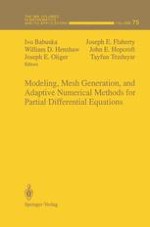1995 | Buch
Modeling, Mesh Generation, and Adaptive Numerical Methods for Partial Differential Equations
herausgegeben von: Ivo Babuska, William D. Henshaw, Joseph E. Oliger, Joseph E. Flaherty, John E. Hopcroft, Tayfun Tezduyar
Verlag: Springer New York
Buchreihe : The IMA Volumes in Mathematics and its Applications
Enthalten in: Professional Book Archive
